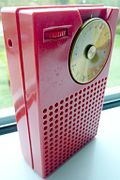The topic of this article may not meet Wikipedia's notability guideline for stand-alone lists .(June 2024) |

This is a list of notable radios, which encompasses specific models and brands of radio transmitters, receivers and transceivers, both actively manufactured and defunct, including receivers, two-way radios, citizens band radios, shortwave radios, ham radios, scanners, weather radios and airband and marine VHF radios. This is a not to be confused with list of radio stations and outline of radio.
















